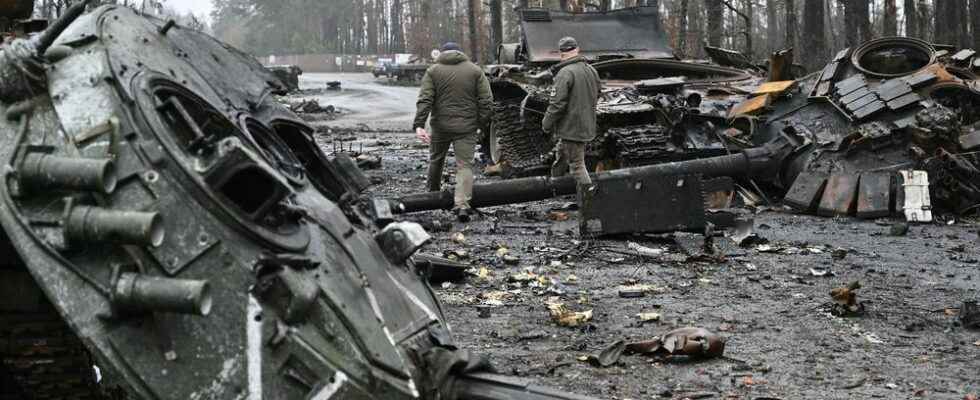Almost four months after the start of the invasion of Ukraine, the war does not seem to be over anytime soon. “We must be prepared for this to last for years,” NATO Secretary General Jens Stoltenberg warned on Sunday June 19 in an interview with the German daily. Picture. On the same day, British Prime Minister Boris Johnson called in a tribune at the Sunday Times to “prepare for a long war”, inviting its allies to provide long-term military support for Ukraine.
In the Donbass, the pocket of Severodonetsk and Lysychansk – two twin cities that constitute the last Ukrainian stronghold in the Lugansk region – continues to resist Russian pressure, despite intense fighting in recent weeks. This situation is forcing Moscow to continue its slow nibbling strategy in the area. This Tuesday, June 21, Putin’s forces would have taken control of the village of Tochkivka, a few kilometers south of the agglomeration, said the Ukrainian authorities. “The Russians manage to advance, but with great difficulty, notes General Dominique Trinquand, military expert and former head of the French mission to the UN. After a while, the front will eventually freeze.”
“No prospect of resolving the conflict”
“Both sides are currently consuming far more resources than they produce or receive, so it’s hard to see how the fighting could continue with such intensity for more than two or three months, agrees Michel Goya, former colonel naval troops, now a historian of the war. The most likely scenario is that the Russians still manage to seize part of the Donbass – for example the whole Severodonetsk-Lyssytchansk zone -, then that the offensive stops for lack of resources.”
Could follow, according to the two experts, a locking of positions and a long period of latent war comparable to that which opposed, before the invasion, the Ukrainian forces to the pro-Russian separatists in the Donbass since 2014. “Either the one of the parties collapses and capitulates, but it seems unlikely for the moment, either the fighting continues, summarizes Marie Dumoulin, former diplomat and director of the Wider Europe program at the European Council for Foreign Relations (ECFR). in any case, we do not see any prospect of settling the conflict.”
Ukrainian soldiers walk between Russian tanks destroyed during fighting in Dmytrivka (west of kyiv), April 2, 2022.
afp.com/Genya SAVILOV
It remains to be seen which army will be best able to support the war effort for a long time. In either case, the troops begin to take the hit. “The Ukrainian forces have probably suffered desertions in recent weeks. However, it is very likely that the morale of the Russians remains particularly disturbed”, indicated on Sunday on Twitter the British Ministry of Defence, reporting “cases of entire Russian units refusing orders and armed clashes between officers and their troops”.
Ukrainian Foreign Minister Dmytro Kuleba said the same day on German television ARD that the Ukrainians were ready to fight “with shovels”, in case they no longer received enough Western weapons, “because this war is a war for our existence”. kyiv reported on Tuesday the arrival in its arsenal of the first German Panzerhaubitze 2000 howitzers, which Berlin had promised to deliver in early May.
Decisive arms deliveries
Last week, Emmanuel Macron had already announced the supply of “six additional Caesar guns” to the 12 already delivered, while the United States released a new aid envelope of one billion dollars, including among other things 18 additional M777 howitzers , and four Himars multiple rocket launchers. “Russia has the advantage of being able to count on huge stocks of armaments inherited from the Soviet era, but Ukraine has the advantage of being able to count on Western deliveries, points out General Trinquand. In the medium term kyiv will rise in power while Moscow will find it much more difficult to replenish its stocks.”
American M777 howitzers delivered by the United States, pictured on April 22, 2022, before being sent to Ukraine
AFP
At issue: a Russian defense industry strongly undermined by American and European sanctions. The two main Russian tank factories were thus forced to interrupt production in March, due to a shortage of Western electronic components. “We have reports from Ukrainians who say that when they find Russian military equipment in the field, it is full of semiconductors that have been removed from dishwashers and refrigerators,” May 11 further said. US Secretary of Commerce Gina Raimondo during a hearing before the Senate.
To succeed in supplying the gigantic Ukrainian needs, the Westerners will still have to manage to increase their production of weapons. According to the agency Reuters, the French Minister of Defense, Sébastien Lecornu, last week asked the Nexter group, which manufactures the famous Caesar cannon, to review its organization in order to be able to deliver it in much shorter delays. The manufacturing process for an artillery piece currently takes about 18 months, according to the company.
Similarly, the American group Lockheed Martin, which produces the Javelin missile launcher, announced on May 8 that it would double its annual production from 2,100 to 4,000 pieces. “In the short term, the time factor rather favors Russia, which has much greater military resources than Ukraine, synthesizes Michel Goya. But if the West manages to get their defense industry going, the trend could be reversed in benefit of Ukraine in the longer term.”
